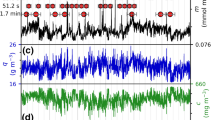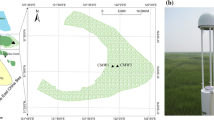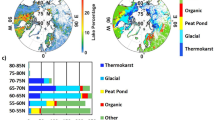Abstract
Methane (\(\mathrm {CH}_{4}\)) is known to be emitted from lakes to the atmosphere via processes such as diffusion and ebullition (i.e., bubble emission). We developed a practical method for partitioning eddy-covariance \(\mathrm {CH}_{4}\) fluxes from a shallow lake into diffusive and ebullitive fluxes using a wavelet analysis based on local scalar similarity between the \(\mathrm {CH}_{4}\) concentration and other reference scalars, such as the air temperature or water vapour concentration, in the wavelet time-scale domain, with the hypothesis that similar and dissimilar fluctuation components are related to diffusive and ebullitive \(\mathrm {CH}_{4}\) fluxes, respectively. Our method is applied to approximately two weeks of data obtained at a shallow mid-latitude lake. The partitioned diffusive flux has a physically sound relationship with wind speed, supporting the validity of the method. The ratio of the diffusive flux to the total flux is typically 0.11 with flow from an area of steady bubble emission, but otherwise 0.36. Further validation is required using a larger dataset and data from other lakes. The proposed method can be easily applied to historical data because it requires only 10-Hz data of \(\mathrm {CH}_{4}\) concentration and other reference scalars, along with an empirical parameter.










Similar content being viewed by others
References
Asanuma J, Tamagawa I, Ishikawa H, Ma Y, Hayashi T, Qi Y, Wang J (2007) Spectral similarity between scalars at very low frequencies in the unstable atmospheric surface layer over the Tibetan plateau. Boundary-Layer Meteorol 122:85–103
Bartlett KB, Crill PM, Sebacher DI, Harriss RC, Wilson JO, Melack JM (1988) Methane flux from the central Amazonian floodplain. J Geophys Res 93:1571–1582
Bastviken D, Cole J, Pace M, Tranvik L (2004) Methane emissions from lakes: dependence of lake characteristics, two regional assessments, and a global estimate. Global Biogeochem Cycles 18:GB4009. https://doi.org/10.1029/2004GB002238
Bastviken D, Tranvik LJ, Downing JA, Crill PM, Enrich-Prast A (2011) Freshwater methane emissions offset the continental carbon sink. Science 331:50. https://doi.org/10.1126/science.1196808
Bock EJ, Hara T, Frew NM, McGillis WR (1999) Relationship between air-sea gas transfer and short wind waves. J Geophys Res 104:25,821–25,831
Boles JR, Clark JF, Leifer I, Washburn L (2001) Temporal variation in natural methane seep rate due to tides, Coal Oil Point area, California. J Geophys Res 106:27,077–27,086
Csanady GT (1990) The role of breaking wavelets in air-sea gas transfer. J Geophys Res 95:749–759
De Bruin HAR, Kohsiek W, Van den Hurk BJJM (1993) A verification of some methods to determine the fluxes of momentum, sensible heat, and water vapour using standard deviation and structure parameter of scalar meteorological quantities. Boundary-Layer Meteorol 63:231–257
De Bruin HAR, Van den Hurk BJJM, Kroon LJM (1999) On the temperature-humidity correlation and similarity. Boundary-Layer Meteorol 93:453–468
Detto M, Katul GG (2007) Simplified expressions for adjusting higher-order turbulent statistics obtained from open path gas analyzers. Boundary-Layer Meteorol 122:205–216. https://doi.org/10.1007/s10546-006-9105-1
Detto M, Katul GG, Mancini M, Montaldo N, Albertson JD (2008) Surface heterogeneity and its signature in higher-order scalar similarity relationships. Agric For Meteorol 148:902–916. https://doi.org/10.1016/j.agrformet.2007.12.008
Eugster W, DelSontro T, Sobek S (2011) Eddy covariance flux measurements confirm extreme CH\(_{4}\) emissions from a Swiss hydropower reservoir and resolve their short-term variability. Biogeosciences 8:2815–2831. https://doi.org/10.5194/bg-8-2815-2011
Foken T (2008) Micrometeorology. Springer, Berlin
Heiskanen JJ, Mammarella I, Haapanala S, Pumpanen J, Vesala T, MacIntyre S, Ojala A (2014) Effects of cooling and internal wave motions on gas transfer coefficients in a boreal lake. Tellus 66B:22827. https://doi.org/10.3402/tellusb.v66.22827
Ikenaka Y, Eun H, Watanabe E, Kumon F, Miyabara Y (2005) Estimation of sources and inflow of dioxins and polycyclic aromatic hydrocarbons from the sediment core of Lake Suwa, Japan. Environ Pollut 138:529–537. https://doi.org/10.1016/j.envpol.2005.04.014
Imberger J (1985) The diurnal mixed layer. Limnol Oceanogr 30:737–770
Iwata H, Kosugi Y, Ono K, Mano M, Sakabe A, Miyata A, Takahashi K (2014) Cross-validation of open-path and closed-path eddy-covariance techniques for observing methane fluxes. Boundary-Layer Meteorol 151:95–118. https://doi.org/10.1007/s10546-013-9890-2
Jessup AT, Zappa CJ, Yeh H (1997) Defining and quantifying microscale wave breaking with infrared imagery. J Geophys Res 102:23,145–23,153
Joyce J, Jewell PW (2003) Physical controls on methane ebullition from reservoirs and lakes. Environ Eng Geosci 9:167–178
Katul G, Goltz SM, Hsieh C-I, Cheng Y, Mowry F, Sigmon J (1995) Estimation of surface heat and momentum fluxes using the flux-variance method above uniform and non-uniform terrain. Boundary-Layer Meteorol 74:237–260
Keller M, Stallard RF (1994) Methane emission by bubbling from Gatun Lake, Panama. J Geophys Res 99:8307–8319
Kimmel SJ, Wyngaard JC, Otte MJ (2002) “Log-chipper” turbulence in the convective boundary layer. J Atmos Sci 59:1124–1134
Kormann R, Meixner FX (2001) An analytical footprint model for non-neutral stratification. Boundary-Layer Meteorol 99:207–224
Kotthaus S, Grimmond CSB (2012) Identification of micro-scale anthropogenic CO\(_{2}\), heat and moisture sources—processing eddy covariance fluxes for a dense urban environment. Atmos Environ 57:301–316. https://doi.org/10.1016/j.atmosenv.2012.04.024
Kumar P, Foufoula-Georgiou E (1994) Wavelet analysis in geophysics: an introduction. In: Foufoula-Georgiou E, Kumar P (eds) Wavelets in geophysics. Academic Press, New York, pp 1–43
Mahrt L (1998) Flux sampling errors for aircraft and towers. J Atmos Oceanic Technol 15:416–429
Martens CS, Klump JV (1980) Biogeochemical cycling in an organic-rich coastal marine basin—I. Methane sediment-water exchange processes. Geochim Cosmochim Acta 44:471–490
Mattson MD, Likens GE (1990) Air pressure and methane fluxes. Nature 347:718–719
McDermitt D, Burba G, Xu L, Anderson T, Komissarov A, Riensche B, Schedlbauer J, Starr G, Zona D, Oechel W, Oberbauer S, Hastings S (2011) A new low-power, open-path instrument for measuring methane flux by eddy covariance. Appl Phys B 102:391–405. https://doi.org/10.1007/s00340-010-4307-0
McGillis WR, Edson JB, Zappa CJ, Ware JD, McKenna SP, Terray EA, Hare JE, Fairall CW, Drennan W, Donelan M, DeGrandpre MD, Wanninkhof R, Reely RA (2004) Air-sea CO\(_{2}\) exchange in the equatorial Pacific. J Geophys Res 109:C08S02
Nakamura H, Owa E (1952) On the “Kama-ana” (non-freezing parts in winter time) of the Suwa-Lake near Okaya-shi, Nagano Prefecture (in Japanese with English abstract). Bull Geol Surv Jpn 3:628–630
Park HD, Iwami C, Watanabe MF, Harada K, Okino T, Hayashi H (1998) Temporal variabilities of the concentrations of intra- and extracellular Microcystin and toxic Microcystis species in a hypertrophic lake, Lake Suwa, Japan (1991–1994). Environ Toxicol Water Qual 13:61–72
Percival DB, Walden AT (2000) Wavelet methods for time series analysis. Cambridge University Press, Cambridge
Podgrajsek E, Sahlée E, Bastviken D, Holst J, Lindroth A, Tranvik L, Rutgersson A (2014a) Comparison of floating chamber and eddy covariance measurements of lake greenhouse gas fluxes. Biogeosciences 11:4225–4233. https://doi.org/10.5194/bg-11-4225-2014
Podgrajsek E, Sahlée E, Rutgersson A (2014b) Diurnal cycle of lake methane flux. J Geophys Res Biogeosci 119:236–248. https://doi.org/10.1002/2013JG002327
Podgrajsek E, Sahlée E, Bastviken D, Natchimuthu S, Kljun N, Chmiel HE, Klemedtsson L, Rutgersson A (2016) Methane fluxes from a small boreal lake measured with the eddy covariance method. Limnol Oceanogr 61:S41–S50. https://doi.org/10.1002/lno.10245
Ripley B, Venables B, Bates DM, Hornik K, Gebhardt A, Firth D (2017) Package ‘MASS’
Rousseeuw PJ, Leroy AM (2003) Robust regression and outlier detection. Wiley, New York
Saito M, Asanuma J, Miyata A (2007) Dual-scale transport of sensible and water vapor over a short canopy under unstable conditions. Water Resour Res 43:W05413
Scanlon TM, Albertson JD (2001) Turbulent transport of carbon dioxide and water vapor within a vegetation canopy during unstable conditions: identification of episodes using wavelet analysis. J Geophys Res 106:7251–7262
Scanlon TM, Sahu P (2008) On the correlation structure of water vapor and carbon dioxide in the atmospheric surface layer: a basis for flux partitioning. Water Resour Res 44:W10418. https://doi.org/10.1029/2008WR006932
Schaller C, Göckede M, Foken T (2017) Flux calculation of short turbulent events—comparison of three methods. Atmos Meas Tech 10:869–880
Schotanus P, Nieuwstadt FTM, de Bruin HAR (1983) Temperature measurement with a sonic anemometer and its application to heat and moisture fluxes. Boundary-Layer Meteorol 26:81–93
Schubert CJ, Diem T, Eugster W (2012) Methane emissions from a small wind shielded lake determined by eddy covariance, flux chambers, anchored funnels, and boundary model calculations: a comparison. Environ Sci Technol 46:4515–4522. https://doi.org/10.1021/es203465x
Sharma S, Magnuson JJ, Batt RD, Winslow LA, Korhonen J, Aono Y (2016) Direct observations of ice seasonality reveal changes in climate over the past 320–570 years. Sci Rep 6(25):061. https://doi.org/10.1038/srep25061
Tang J, Zhuang Q, Shannon RD, White JR (2010) Quantifying wetland methane emissions with process-based models of different complexities. Biogeosciences 7:3817–3837. https://doi.org/10.5194/bg-7-3817-2010
Thomas C, Martin JG, Goeckede M, Siqueira MB, Foken T, Law BE, Loescher HW, Katul G (2008) Estimating daytime subcanopy respiration from conditional sampling methods applied to multi-scalar high frequency turbulence time series. Agric For Meteorol 148:1210–1229. https://doi.org/10.1016/j.agrformet.2008.03.002
Tokida T, Miyazaki T, Mizoguchi M (2005) Ebullition of methane from peat with falling atmospheric pressure. Geophys Res Lett 32(L13):823. https://doi.org/10.1029/2005GL022949
van de Boer A, Moene AF, Graf A, Schüttemeyer D, Simmer C (2014) Detection of entrainment influences on surface-layer measurements and extension of Monin–Obukhov similarity theory. Boundary-Layer Meteorol 152:19–44
Varadharajan C, Hemond HF (2012) Time-series analysis of high-resolution ebullition fluxes from a stratified, freshwater lake. J Geophys Res 117(G02):004. https://doi.org/10.1029/2011JG001866
Vickers D, Mahrt L (1997) Quality control and flux sampling problems for tower and aircraft data. J Atmos Oceanic Technol 14:512–526
Walter KM, Smith LC, Chapin FS (2007) Methane bubbling from northern lakes: present and future contributions to the global methane budget. Philos Trans R Soc 365:1657–1676. https://doi.org/10.1098/rsta.2007.2036
Wanninkhof R (1992) Relationship between wind speed and gas exchange over the ocean. J Geophys Res 97:7373–7382
Wanninkhof R, Asher WE, Ho DT, Sweeney C, McGillis WR (2009) Advances in quantifying air-sea gas exchange and environmental forcing. Annu Rev Mar Sci 1:213–244. https://doi.org/10.1146/annurev.marine.010908.163742
Webb EK, Pearman GI, Leuning R (1980) Correction of flux measurements for density effects due to heat and water vapour transfer. Q J R Meteorol Soc 106:85–100
Wik M, Varner RK, Anthony KW, MacIntyre S, Bastviken D (2016) Climate-sensitive northern lakes and ponds are critical components of methane release. Nat Geosci 9:99–105. https://doi.org/10.1038/NGEO2578
Xu X, Riley WJ, Koven CD, Billesbach DP, Chang RYW, Commane R, Euskirchen ES, Hartery S, Harazono Y, Iwata H, McDonald KC, Miller CE, Oechel WC, Poulter B, Raz-Yaseef N, Sweeney C, Torn M, Wofsy SC, Zhang Z, Zona D (2016) A multi-scale comparison of modeled and observed seasonal methane emissions in northern wetlands. Biogeosciences 13:5043–5056. https://doi.org/10.5194/bg-13-5043-2016
Zappa CJ, Asher WE, Jessup AT (2001) Microscale wave breaking and air-water gas transfer. J Geophys Res 106:9385–9391
Acknowledgements
We thank Mr. Hiroshi Moriyama for allowing us to use the pier for observations. Constructive comments from Prof. T. Foken and two anonymous reviewers helped to improve this manuscript. Dr. C. Schaller kindly provided his program code to calculate the short-term fluxes. This study was funded by a grant from the Japan Society for the Promotion of Science (JSPS) KAKENHI (no. 17H05039). The program code to perform the flux partitioning developed here is available from the author upon request (Hiroki Iwata, hiwata@shinshu-u.ac.jp).
Author information
Authors and Affiliations
Corresponding author
Electronic supplementary material
Below is the link to the electronic supplementary material.
Rights and permissions
About this article
Cite this article
Iwata, H., Hirata, R., Takahashi, Y. et al. Partitioning Eddy-Covariance Methane Fluxes from a Shallow Lake into Diffusive and Ebullitive Fluxes. Boundary-Layer Meteorol 169, 413–428 (2018). https://doi.org/10.1007/s10546-018-0383-1
Received:
Accepted:
Published:
Issue Date:
DOI: https://doi.org/10.1007/s10546-018-0383-1




